Introduction The month experienced substantial precipitation compared to previous months
Introduction
The month experienced substantial precipitation compared to previous months. Pasture and water for wildlife is still adequate. There was one incident involving standoff between the management of Mara North Conservancy and surrounding community whereby elephants who had crossed to Merti were said to have been shot with spears and arrows by the youths in that area. It took the intervention of KWS officers and Mara elephant project team for the elephants to be spared further injuries. It was reported that more than eight elephants were injured during the standoff, but rigorous search for these injured elephants involving use of a helicopter was unsuccessful. One elephant with suspected gunshot injury was however located and treated. He is thought to have been part of the group that was harassed. Following are interventions and activities carried out during the month.
Case #1 Collection of faecal materials from Plain zebras:
Date: 4th to 8th August 2014
Species: Plain Zebras
Loaction: Masai Mara Ecosystem
History and Research:
This was a one week activity which involved collection of faecal materials from resident and migratory common zebras within Masai mara ecosystem. This aims at determining the type and distribution of parasites among this species and to know whether these parasites are pathogenic to other wildlife species and domestic animals. The exercise was conducted in collaboration with a research team from KWS headquarters and the University of Nairobi. Over 600 samples were collected and will be analyzed at KWS and University of Nairobi laboratories. The exercise went on smoothly.
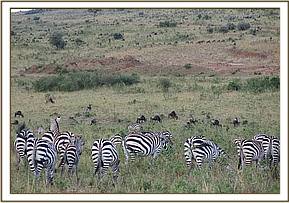

Case #2 Bull elephant at Mara bush tops:
Date: 8th August 2014
Species: Elephant
Sex: Male
Loaction: Mara Bush Tops
History:
Mara Bush top security team spotted this massive bull elephant isolated. Though feeding, the elephant had a fresh wound on lateral surface of his right thigh. There were two old healing wounds on his left thigh and another healed scar on his left elbow.
Immobilization and examination:
This bull was immobilized by use of 17mgs etorphine hydrochloride delivered through a 3ml dart by Daninject darting system. A vehicle was used to dart this elephant. The drugs took 15minutes to take full effect with the elephant assuming sternal recumbency. The old wounds were quickly examined and managed before the elephant was flipped over to lie laterally on his left side. This was to avoid respiratory complications since sternal recumbency can compromise breathing. It is at this point that we discovered this was an elephant we treated two months before at Siana conservancy. The earlier wounds were fast healing. The one on the left elbow had completely healed while the one on the left thigh was almost healing.
Treatment:
This wound was cleaned with hydrogen peroxide and disinfected with iodine dipped swabs.Oxyteracycline wound spray was applied before green clay being packed. The elephant was then flipped over to lie on his left side. This revealed a fresh spear wound about four inches wide and eight inches deep on the lateral surface of his right thigh. The wound could have been inflicted one day before the intervention. This fresh wound was managed the same way as the other wound. Additional treatment involved administration of 15000mgs of Amoxycillin antibiotic and 2000mgs Flunixin meglumine anti-inflammatory intramuscularly as well as multivitamin injection.
Reversal:
Reversal was achieved by administration of 48mgs diprenorphine hydrochloride through the ear vein. The elephant woke up after two minutes and walked away. Both the KWS security team present and Bush top counterparts were advised to monitor and protect this elephant which appears a group is determined to poach him.
Prognosis: Good
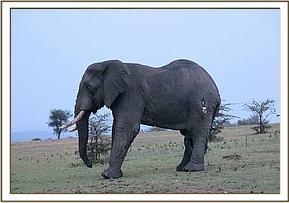
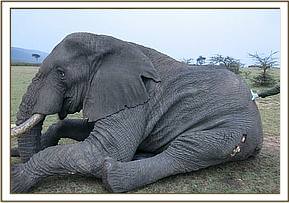

Case #3 Bull elephant at Mararianta:
Date: 11TH August 2014
Species: Elephant
Sex: Male
Location: Mararianta
History:
This elephant was suspected to be one of a group that was harassed by community when they crossed over from Mara North conservancy to community farms in Marti three days before intervention. It was reported that there was a standoff between KWS and Mara elephant project security officers on one hand and youths from the community on the other hand who wanted to spear the elephants on allegations of crop destruction by these elephants. The youths said to number over 200 armed with spears, bows and arrows were adamant to let the elephants be driven back to the conservancy. It took quite some time for the youths to let the elephants be driven back to the conservancy but with some having been speared and others shot with arrows.
General examination:
This elephant had obvious pain while walking. He was limping on his left front limb with slight swelling of this limb at carpus. He was still feeding and active though. The elephant was in a rocky valley close to a stream.
Immobilisation, examination and treatment:
Given that the terrain was not good for immobilisation, services of a helicopter which was used to search for the other elephants were requested. This was to assist in moving the elephant to a better terrain and to dart. 17mgs etorphine was used to dart this elephant through 2ml Daninject dart. Darting was done from helicopter after driving this elephant to an open and clear ground. It took eight minutes for the drug to take full effect with the elephant assuming sternal recumbency. The elephant was immediately pushed over to lie on his left side. Examination revealed a penetrating wound on the medial aspect of the left carpus with a ventro- dorsal course. The wound was still fresh about three days old. The joint was slightly swollen but still intact and mobile. This appeared to have been caused by a bullet that did not exit. The joint integrity and surrounding bony tissues were not affected. The bullet appeared to have lodged itself on the soft tissues. Treatment involved debriding the wound with hydrogen peroxide, use of iodine to disinfect, application of cloxacillin ointment and finally packing it with green clay.20000mgs of oxytetracycline antibiotic and 2500mgs Flunixin meglumine anti-inflammatory was given intramuscularly. Given that no bony tissue was involved and the joint is intact, the bullet will be walled off and isolated from other tissues and hopefully will not interfere with normal functions of the limb. The elephant can live with this without any problem.
Reversal:
Reversal achieved by administration of 48mgs diprenorphine hydrochloride through the ear vein. The elephant woke up and strode away after three minutes.
Prognosis: Favourable.






Case #4 Lioness at Ololoolo gate:
Date: 16th August 2014
Species: Lioness
Sex: Female
Location: Ololoolo Gate
History:
This lioness was spotted by anti-snaring team from Kichwa Tempo isolated and lying most of the time. The lioness had a big swelling on the left side of her neck and an open wound on the base of her right ear.
Immobilization, examination and treatment:
Immobilization was achieved by use of a combination of 220mgs Ketamine and 4mgs medetomidine delivered through a 1.5ml Daninject dart. Darting was done by use of vehicle. It took seven minutes for the drug to take full effect. Cloxacillin eye ointment was applied to both eyes and face towel put in place. Examination revealed that this lioness suffered fight wounds from other lions. The wounds were cleaned by use of hydrogen peroxide, iodine and clean swabs.Cloxacillin ointment was also put on the wounds with topical oxytetracycline spray being applied.Additionally, 3000mgs amoxicillin antibiotic and 16mgs Dexamethasone sodium anti-inflammatory was given intramuscularly. To reduce internal and external parasite load, 80mgs ivermectin parasiticide was given subcutaneously.
Reversal:
Reversal achieved by intramuscular administration of 15mgs atipamizole one hour after immobilization. The lioness woke up after ten minutes and walked away.
Prognosis: Good.



Case #5 Tissue and faecal sampling for hydatidosis in wildlife in Mara:
Date: 20th August and 26th August 2014
Location: Masai Mara Ecosystem
History and Examinations:
This exercise which was carried out between 20th August 2014 and 26th August 2014 is collaboration between KEMRI, KWS and Meru University. This project has been going on for the last four years.Hydatidosis is a serious parasitic zoonosis common in some parts of Kenya especially marginal pastoral areas. It is caused by cystic stages of Echinococcus granulosus . Definitive host is domestic dog with cystic stages found in domestic herbivores. Dogs feeding on infected herbivores will ingest the cysts and further development occurs in the dog. The cycle is completed when eggs of this parasite are passed through dog’s faeces and eventually being picked by grazing herbivores.Occasionally, due to close contact of man and domestic dogs, eggs of this parasite can accidentally be picked by human beings from dog faeces especially where hygiene is a problem. Ingestion of eggs from infected dog faeces will lead to disease in humans. In humans development will stop at cystic stage with development of big cysts in areas such as liver, lungs and even heart. The cysts could contain large volumes of fluid sufficient to impair functions of these organs and can lead to fatalities. Interesting findings show that some wildebeests harbour the cystic form of this parasite. Lung and liver samples collected from wildebeests that die from crossing Mara River have shown that some harbour this parasite.Faecal samples from wild carnivores have shown some of them pass eggs of this parasite. Research is therefore being conducted to show whether there is a link between this and the well understood domestic cycle especially in areas where domestic animals have access to the parks.
Sampling:
Sampling involved collection and analysis of lung, liver and heart tissues of dead wildebeests, and collection of fresh faecal samples from wild carnivores for examination of this parasite. Results of this investigation can provide an insight on better ways of arresting the sustenance of the parasite’s cycle.
Case #6 Treatment of Sienna, the marsh pride lioness:
Date: 23rd August 2014
Species: Lion
Sex: Female
Age: Adult
Location: Masai Mara Marsh Lands
History:
It is more than four months since sienna got a nasty injury after being gored by a buffalo. Sienna’s three cubs by then were still small and heavily dependent on her. Quick intervention through skyvet initiative and follow up treatments saved her life. She has been recovering well with a small scar remaining. All her cubs are doing well and in good health. On the night of 22nd August 2014, Sienna picked a fight with another female from neighbouring pride. The result was not good with the Governor’s camp management calling the veterinary unit for immediate intervention. Sienna’s previous wound had been ripped open and both her hindquarters had been bitten leaving her lying most of the time.
General examination:
Sienna was seen lying under a tree obviously in lots of pain. The previous wound was open and bleeding. She was in company of her three cubs and an older daughter. All of them were full and seem to have fed recently. A decision was made to immobilize her for closer examination and treatment.
Immobiliszation, examination and treatment:
Sienna was immobilized by use of 5mgs medetomidine and 250mgs Ketamine delivered through a 1.5ml Daninject dart. Darting was done from a vehicle. She was immobilized after ten minutes we added another 1mg medetomidine to maintain anaesthesia because repair procedure would be reasonably long. Examination revealed several fight wounds on both of her thighs and more serious was the previously healing wound which had been ripped open and bleeding. The wound was disinfected with surgical spirit before being closed. The margins of the wound were shaved and trimmed before deep and subcutaneous sutures being put in place using No 2 USP chromic catgut; this was followed by flushing the wound with iodine and applying cloxacillin ointment before apposing the skin using No1USP vicryl suture. All suture patterns were simple interrupted. Oxytetracycline spray applied topically. The other bite wounds on the thighs were cleaned, debrided with hydrogen peroxide and disinfected with iodine before cloxacillin ointment and oxytetracycline spray being applied. A paste of green clay was then applied to all the wounds. Additional treatments involved intramuscular injection of 3000mgs amoxicillin antibiotic and 20mgs Dexamethasone sodium anti-inflammatory and subcutaneous injection of 100mgs ivermectin parasiticide to take care of internal and external parasites. The whole procedure took one hour.
Reversal:
Reversal was achieved by intramuscular administration of 15mgs atipamizole one hour after darting. She woke up after eight minutes and walked away.
Prognosis: Good.

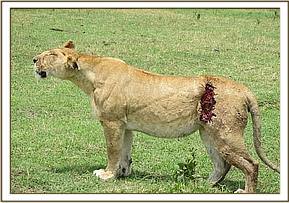
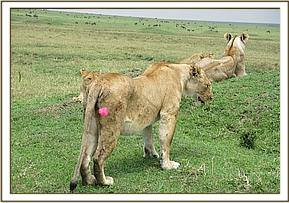

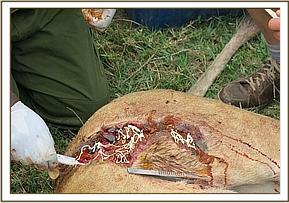
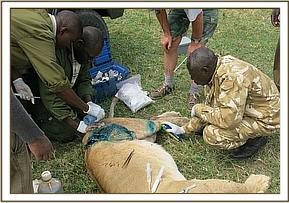
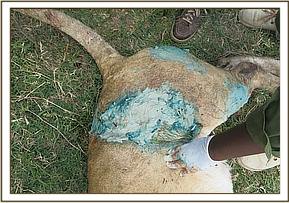

Case #7 Speared Giraffe:
Date: 28th August 2014
Species: Giraffe
Sex: Male
Location: Kawaii, Olkurruk airstrip
History:
This male giraffe was spotted by Mara triangle rangers in a group of other giraffes with a spear sticking from his neck. They immediately sought our services to rescue him.
General observation:
The giraffe was in a group of more than twenty others with the spear sticking out from the left side of his neck. The giraffe was still strong and was seen chewing the cud. He was active and kept pace with the rest of the herd.
Immobilization, examination and treatment:
This giraffe was chemically immobilized by use of 12mgs etorphine and 60mgs azaperone delivered through Daninject dart from a vehicle. The drugs took eight minutes to take full effect. Upon recumbency etorphine was reversed with diprenorphine to avoid capture complications and worked on when he was conscious but calmed by azaperone. The retrieved spear had penetrated deep into the neck muscles but fortunately had not damaged any of the vital organs. The depth of the wound was about eight inches. The spear could have been in place for the past three days before intervention. The wound was not infected. The resultant wound was cleaned with water, debrided with hydrogen peroxide before iodine disinfectant being applied. Oxytetracycline spray was then applied topically. In addition 6000mgs oxytetracycline antibiotic and 26mgs Dexamethasone sodium anti-inflammatory was given intramuscularly before the giraffe was released.
Prognosis: Good
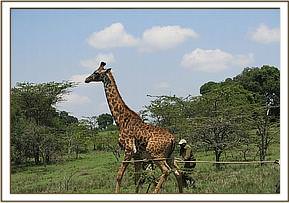
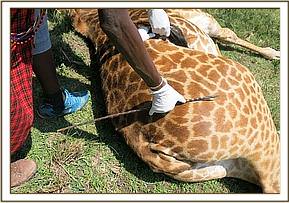

Case #8 Snared Warthog:
Date: 27th August 2014
Species: Warthog
Sex: Male
Location: Kitchwa Tembo Camp
History:
This warthog was spotted by the Kichwa Tempo security staff with a tight wire round his waist. This warthog for sometime was elusive and could not be seen but we were able to find him this day.
Immobilization and treatment:
He was in a company of other three warthogs close to a stream with the wire seen round his waist. He appeared uncomfortable though grazing. This warthog was chemically immobilized by use of 2.5mgs etorphine and 15mgs azaperone. The drugs took effect after five minutes and the warthog was placed under a shade. Examination revealed a tight snare made of plain wire round his waist. The wire had created a wound on ventral part of the abdomen with slight damage of rectus abdominis muscles. The snare appeared to have been in place for at least eight days with fly maggots already infesting on the wound. The snare was duly removed and wound washed with copious amount of water and hydrogen peroxide. All the maggots were removed and iodine used to disinfect the wound. Oxytetracycline spray was applied topically before coating it with green clay.Adittionally, 1500mgs amoxicillin antibiotic and 400mgs Flunixin meglumine anti-inflammatory was given intramuscularly. To rid further maggot infestation, external and internal parasites, 40mgs ivermectin parasiticide was administered subcutaneously.
Reversal:
Reversal achieved by administration of 12mgs diprenorphine hydrochloride intravenously through ear vein. He woke up immediately and dashed to where other warthogs had gone.
Prognosis: Good.
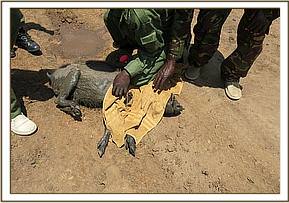
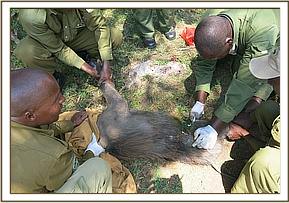
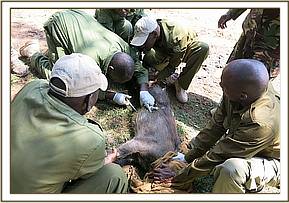

Case #9 Wounded Elephant bull:
Date: 27th August 2014
Species: Elephant
Sex: Male
Age: Sud - Adult
Location: Mara Triangle
History:
This young bull about 20years was spotted by Mara triangle patrol rangers in a family of about ten elephants. He had an obvious wound on left hind limb and appeared restless although still feeding.
General observation:
This elephant though in good body condition was restless and kept on lifting the affected limb and occasionally stamping it on the ground.
Immobilization, examination and treatment:
Immobilization was achieved by use of 15mgs etorphine delivered in a 1.5ml Daninject dart. The drugs took effect after eight minutes with the elephant lying on his left side. Examination of the affected limb showed this elephant had once been snared when young with the resultant scar getting abrassed at the heal. The wound was complicated by maggots which had infested causing a lot of discomfort to this elephant. All the maggots were removed, wound lavaged with copious amount of water and hydrogen peroxide used to debride the dead debris. The wound was swabbed clean before iodine disinfectant and oxytetracycline antibiotic spray being applied topically. Green clay was then packed to absorb toxins and promote healing. Additionally 15000mgs amoxicillin antibiotic and2500mgs Flunixin meglumine anti-inflammatory was given intramuscularly.400mgs ivermectin injection was given subcutaneously against both internal and external parasites.
Reversal:
Reversal was achieved by administration of 42mgs diprenorphine through the ear vein. The elephant woke up after two minutes and joined the other members of the family.
Prognosis: Good
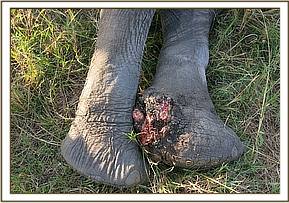
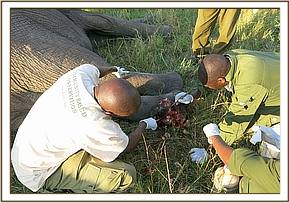
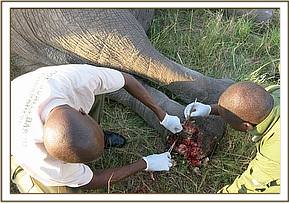


Case #10 Lion cub with a wound:
Date: 28th August 2014
Species: Lion
Sex: Male
Age: Sub - Adult
Location: Ololoolo Area, Mara Triangle
History:
This young lion was seen in company of three other cubs thought to be his siblings. Their mother could not be seen but suspected to have gone to hunt. The four lion cubs had been tracked for a while that day by the Mara triangle rangers who saw this particular cub with a wound on the right side of his withers. The wound appeared infected.
Capture, examination and treatment:
This young lion was seen under a tree alone. The other cubs were further away. He was immobilized chemically by use of a combination of 2mgs medetomidine and 110mgs Ketamine in a 3ml Daninject dart. It took eight minutes for this lion to be fully sedated. Examination revealed a septic wound probably acquired through a scuffle with other lions on the right side of his withers. The wound was slightly deep and already infested with maggots. This wound could have been there for at least four days before intervention. The maggots were duly removed and wound washed with water and hydrogen peroxide. Iodine was used to disinfect and oxytetracycline spray applied. Green clay was then packed. Aditionally, this lion was given 1500mgs amoxicillin antibiotic intramuscularly and 40mgs ivermectin subcutaneously against internal and external parasites.
Reversal:
Reversal was achieved by use of 7.5mgs atipamizole given intramuscularly one hour after immobilization. He woke up after ten minutes and walked towards the other cubs.
Prognosis: Good

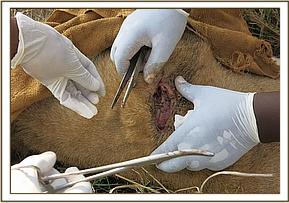


Conclusion:
Mara mobile veterinary unit would like to thank everyone who in one way or another contributed to various interventions carried out during the period. Much thanks to KWS management and Minara foundation through The David Sheldrick Wildlife trust who have continued to facilitate the unit.
Report by: Dr.Campaign K. Limo.